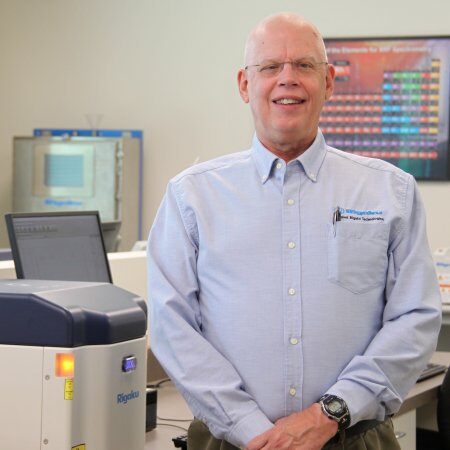Application Note EDXRF3209

Scope
This application note demonstrates the analysis of coal with specific emphasis on the measurement of sodium (Na), using the NEX CG II. The Rigaku Fundamental Parameters (FP) approach with Matching Library was used for the measurements. Semi-quant FP with no Matching Library is also shown, ideal for screening minor elements and heavy metal content.
Background
Coal has many uses as an energy source. Coal’s primary use is for electricity generation, and it is also used in steelmaking and cement production, as well as many other industrial uses. Coal-fired power plants also collect coal fly ash for use in making cement, road construction materials, agricultural soils, and environmental remediation.
During the mining, processing, and burning of coal, process monitoring and control are vital to the efficiency and quality of the final product. At a coal-fired power generation plant, specific attention is often given to the sodium (Na) content, occurring in organic and inorganic forms. High sodium content can combine with sulfur (S) or aluminum (Al) and silicon (Si) to form sodium sulfate or sodium alumina-silicate compounds. Such compounds, formed when burning high-sodium coals, can lead to fouling of the cyclone or heat exchange surfaces.
Coal is typically graded by the sodium (Na) and sulfur (S) content, as well as the energy content as carbon (C).
| Coal type grade, highest to lowest | Typical Na levels | Typical S levels | Typical energy content (carbon content) |
| Anthracite | Trace | Very low, <1%, 0.2 – 0.9% | 86 – 92% |
| Bituminous | Trace to ultralow | Mid-range, 0.1 – 4% | 76 – 86% |
| Sun-bituminous | Low to % levels | Medium, 0.3 – 2% | 70 – 76% |
| Lignite | Low to % levels | Wide range, 0.5 – 10% | 65 – 70% |
Whether screening incoming raw materials, monitoring production processes, or QA/QC out-processing, a fast, simple, and accurate method for analyzing samples is important throughout the production cycle. Rigaku offers the NEX CG II EDXRF analyzer to meet the challenge of analyzing low-sodium coals.
The NEX CG II utilizes indirect excitation and polarization to provide unmatched sensitivity, with best-in-class detection limits for the light elements like sodium (Na) and screening for minor elements and heavy metals. It can reliably measure from sodium (Na) to uranium (U) and is simple enough for use by non-technical operators, yet powerful enough for expert use in research.
Rigaku RPF-SQX Fundamental Parameters (FP)
Rigaku RPF-SQX FP software estimates elemental concentration based on XRF theory called Fundamental Parameters (FP). Rigaku Profile Fitting (RPF) automatically deconvolutes spectral peaks and models the sample matrix using fundamental XRF equations to provide semi-quantitative measurements of elemental concentrations without needing any known standards, called semi-quantitative or semi-quant analysis. The balance component in the method is set to carbon (C) to best model the unmeasurable part of the coal sample, which gives the operator an estimate of the energy content.
Rigaku user-defined matching library
The user can easily tune the FP results using Matching Libraries by measuring one or more samples of the actual coal with known elemental assay values from a referee technique such as ICP. In this way, the RPF-SQX FP can be tuned to the actual coal source and type and the ICP referee numbers. This capability allows Rigaku RPF-SQX FP to reliably model variations in elemental and oxide composition, as well as estimate carbon content. As a result, it ensures optimum accuracy and reliable, high-quality data.
The use of Matching Libraries is demonstrated here for bituminous coal. Two site-specific coal samples from the field were assayed by ICP to create Matching Libraries for sodium (Na), sulfur (S) and the major oxides. Semi-quant standardless analysis was used to measure the other elements present for informational or screening purposes.
NEX CG II results
Typical results are shown here for bituminous coal. Note that sodium (Na) and sulfur (S) can be present in coal in both organic and inorganic forms.
| Unknown coal sample #252 FP with Matching Library | |||
| Component | ICP Value (mass%) | NEX CG II Result (mass%) | Stat. Err. |
| Na | 0.131 | 0.177 | 0.0077 |
| MgO | 0.273 | 0.279 | 0.0042 |
| Al₂O₃ | 0.865 | 0.895 | 0.0019 |
| SiO₂ | 1.750 | 1.730 | 0.0018 |
| S | 0.120 | 0.119 | 0.0001 |
| K₂O | 0.018 | 0.018 | 0.0005 |
| CaO | 1.403 | 1.390 | 0.0020 |
| TiO₂ | 0.091 | 0.085 | 0.0004 |
| Fe₂O₃ | 0.360 | 0.310 | 0.0007 |
| Unknown coal sample #252 Standardless Semi-quant FP | ||
| Component | NEX CG II Result (mass%) | Stat. Err. |
| P₂O₅ | 0.0328 | 0.0001 |
| Cl | 0.0028 | <0.0001 |
| SrO | 0.0155 | <0.0001 |
| BaO | 0.0129 | 0.0003 |
| Carbon Balance | 94.8 | N/A |
Heavy metal screening
Standardless semi-quant FP is also suitable for screening heavy metal content.
| Unknown coal sample #252 Heavy metal screening | |
| Element | NEX CG II Result (ppm) |
| Pb | (0.60) |
| Hg | ND |
| As | 0.40 |
| Cr | (0.91) |
| Cd | ND |
Conclusion
The Rigaku NEX CG II, using the RPF-SQX Fundamental Parameters method coupled with a simple to create 2-point Matching Library, yields excellent performance for the elemental analysis of coal, achieving ultra-low measurements of the sodium (Na) content. The use of RPF- SQX significantly reduces or even eliminates the need for large suites of calibration standards. Rigaku’s approach to FP combines automatic peak deconvolution with advanced matrix modeling to give the user a simple and powerful state-of-the-art system. The results shown here indicate that the NEX CG II is an excellent tool for the analysis and quality control of coal.

